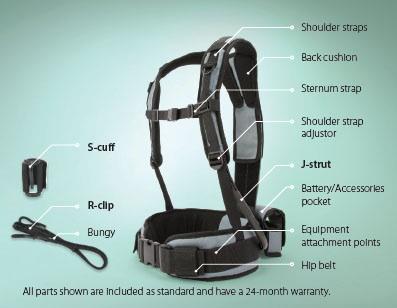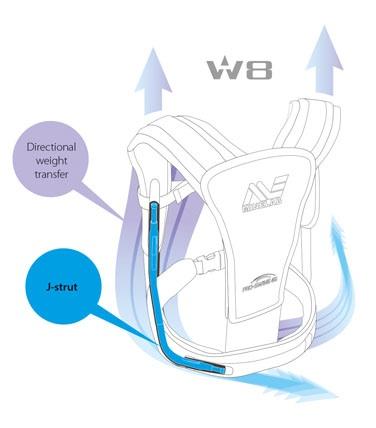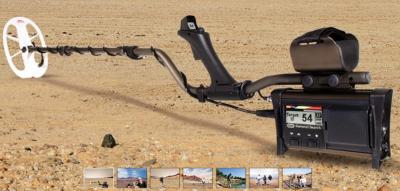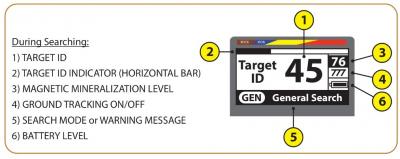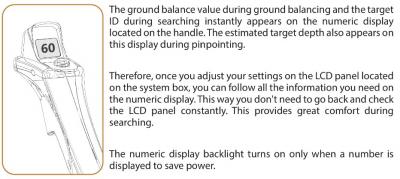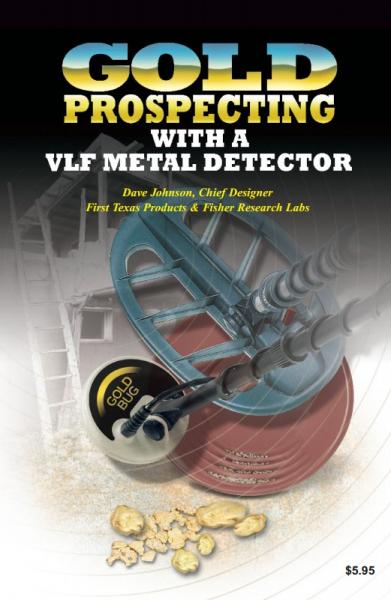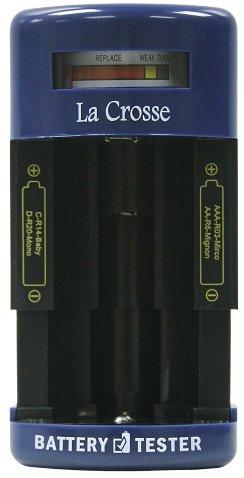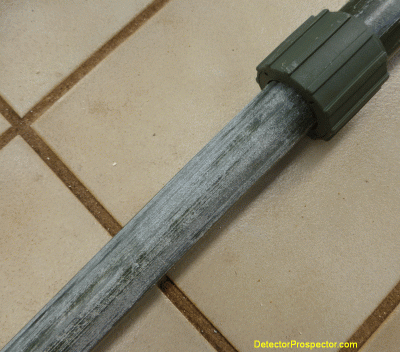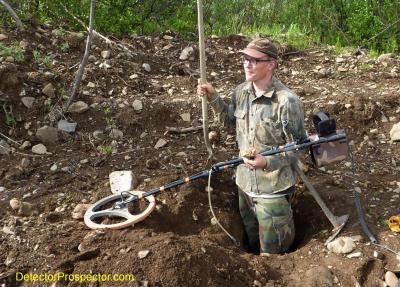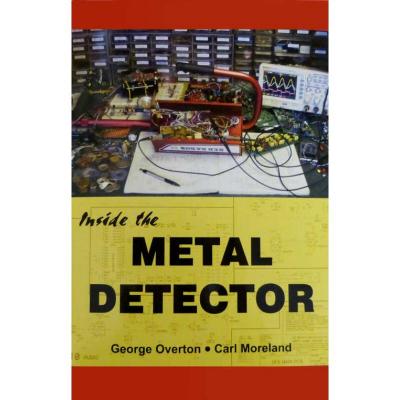-
Posts
19,773 -
Joined
Content Type
Forums
Detector Prospector Home
Detector Database
Downloads
Everything posted by Steve Herschbach
-

Minelab Pro-Swing 45 Harness
Steve Herschbach replied to Rick K - First Member's topic in Minelab Metal Detectors
I use the Pro-Swing 45 with the Garrett ATX for anything more than a couple hours use. Excellent harness and a good investment for any ATX owner or anyone who has issues with detector weight. It will work with any model detector. Manufacturers website http://www.minelab.com/usa/products/consumer/accessories-1/harness-1/pro-swing-45 -
Nokta Engineering is a company based in Turkey since 2001. It appears they are looking to cash in on the Africa gold rush with a new detector model called the FORS Gold. I have to admit to being biased towards mainline name brand detectors. I want warranty service backed up in the US and widespread parts and accessory availability via a US based dealer network. I also prefer to own detectors that are well known and therefore easily sold when and if I decide to do so. However, there are interesting things happening outside the US when it comes to metal detectors, particularly in Europe. Minelab is proof the US manufacturers get complacent and ignore market demands in other countries. Minelab addressed desires in Australia for better prospecting detectors and European manufacturers are pursuing detectors made to extract non-ferrous targets buried in piles of ferrous trash. So I do keep an eye on what is going on elsewhere, just in case. In all honesty the Nokta FORS Gold appears to me to be "Just Another Mid-Frequency Gold Detector". The market is awash in VLF detectors running at 12kHz to 20kHz set up to do it all while being good on gold. The Nokta FORS Gold hits the 15kHz sweet spot in a 4.3 lb multi-use package available through US importer Kellyco for $699. It comes stock with a 7" x 11" DD coil and has a couple coil options, a 5" round DD and 13" x 15" DD. Not too much here out of the ordinary but I did find a couple things interesting. The unit has an LED flashlight built into the handle that illuminates the coil area. But what I really found intriguing is a built in handle vibrate mode much like we have in the Garrett and Minelab pinpointers. This could be a real aid for people with extreme hearing issues and in fact might allow a completely deaf individual to effectively metal detect with having to have eyes glued on meter. I like that. 10/16/2014 Update - I now have a Nokta FORS Gold. See my very detailed review at http://www.detectorprospector.com/forum/topic/352-detailed-review-of-the-nokta-fors-gold-nugget-detector/ More Information on the Nokta FORS Gold Metal Detector
-
From Interview with Dave Johnson at http://www.fisherlab.com/hobby/davejohnson/Interview%20with%20David%20Johnson.pdf Many of the people reading this interview unknowingly own products of your design. Would you mind listing them? My first metal detector (in 1971) was a portable experimental vehicle detector for use on roadway loops. It discriminated between cars and trucks, but to become a practical product would have required a lot of development and nobody was interested in investing in it. Fisher in California: 1260, 1220, 1210, 1235, 1225, 1212, 1265, 1266, CZ6, CZ5, CZ20, original Gold Bug, Gold Bug II, Gemini, and industrial instruments including TW6, FX3, XLT-16, PF-18, and circuitry of the TW-770. Tesoro: Diablo MicroMax, Lobo SuperTraq. White's: GMT, MXT, analog circuitry of DFX, Beach Hunter and PCL-600 line tracer. Troy: X-5 and X-3. FTP Bounty Hunter: major revisions to existing platforms most of which originated with George Payne. The BH Junior, Platinum, Gold and security wand (sold under various trademarks) were new designs. FTP Teknetics: T2, Alpha, Delta, Gamma, Omega, G2. FTP Fisher: F2, F4, F5, F75, F70, new Gold Bug, circuitry of the TW-82 industrial line tracer. In the case of microprocessor-driven FTP products, the software was coded by John Gardiner and Jorge Anton Saad. Mechanical designs were done mostly by other people, but I engineered the ergonomics of the T2 mechanical design, which is also used on the F75. See also Detector Stuff Interviews FT-Fisher Engineers, David Johnson and John Gardiner at http://detectorstuff.com/detector-stuff-interviews-ft-fisher-engineers-david-johnson-and-john-gardiner/ More Dave Johnson Essays here Want people to know you own one of the Dave Johnson detectors listed above? Just download and print the attached logo and apply to your detector!
-
Gold Prospecting with a VLF Metal Detector by Dave Johnson Chief Designer, First Texas Products & Fisher Research Labs March 2010 Edition This book explains how to use a VLF metal detector for finding gold. The author has nearly 30 years’ experience in the metal detector industry working for several different companies, and designed several of the most popular “gold machines” on the market. These include the Tesoro Lobo, White's GMT and MXT, and of course the Fisher Gold Bug and Gold Bug 2. Although the product emphasis is on the machines currently “Made in El Paso”, the features of competitors’ machines are also discussed. This booklet is useful no matter what brand of metal detector you use. pdf download 29 pages You can find this and many more useful free books on this website at the Metal Detecting & Prospecting Library
-

An ATX Proposal
Steve Herschbach replied to Rick K - First Member's topic in Garrett Metal Detectors
Don't get me wrong, I would like to see all detectors cost as little as possible. I was talking more from a theoretical perspective. I admit to being very spoiled. Detectors cost less in the US, and I never pay retail. I can always just call my old shop and get one for about 10% over dealer cost. I have had a lot of detectors given to me free in return for providing feedback good or bad about them. But back to the subject. I could really use a properly designed lightweight ergonomic ATX. If the price came down in the process, all the better! No matter how you look at it Garrett deserves credit for putting out some significant power at a very competitive price with the ATX. I am certain the military paid a whole lot more for the AML-1000! Hopefully increased competition will help keep a lid on prices or start bringing them down in the future. I would expect we will see lots of used ATX detectors available at lower prices used very soon as people who get them thinking they are something they are not sell them almost new. Ricks idea of light weight rod and coil assemblies for the existing model has a lot of merit. Aftermarket opportunity calls! -

Video About Gold Detecting In Africa
Steve Herschbach replied to Steve Herschbach's topic in Detector Prospector Forum
The Teknetics T2 is extremely popular in Africa, and while even it may still be overkill it is a better match for the type of detecting over there than a PI in most cases. Certainly more affordable for those people. Good machine the T2, I found a lot of gold with the Fisher version, the F75. -

An ATX Proposal
Steve Herschbach replied to Rick K - First Member's topic in Garrett Metal Detectors
First off Rick, sounds good to me! You are however making an assumption. There is an expectation a dry land ATX would cost less. Makes sense because a dry land version would cost less to make, right? There is no law says it must be so. What if Garrett came out with a very well designed 3.9 lb. dry land ATX tomorrow and it was priced the same as the existing ATX? New purchasers could simply chose which they want for the same price. I suspect most would choose to get the dry land version. The waterproof capability of the ATX comes at a definite cost in weight and other factors. In fact, this is a case where I would pay MORE to get the light weight version! There are plenty if examples whereby smaller, sexier, and high tech costs more than old fashioned and large. The bottom line is the ATX is not overpriced no matter what box it comes in. There is also the reality of the ATX leveraging off the shelf hardware. A dry land unit would actually need some work to develop a new box and light weight coil set and so in theory would cost more to bring to market than the ATX did. I have always been my best test customer. I would buy a light weight dry land version of the ATX tomorrow if it were available and not complain at all if the price were the same as the existing unit. Just food for thought. -
I would not want to use it in water myself. There is a form fitting water version in the works.
-
I found this quite interesting and well done. This video report features interviews with Minelab and a number of customers from Burkina Faso. It was filmed in Burkina Faso and Dubai. It also tells the stories of a number of customers and how their success has changed their lives. One prospector, Solomon, struck it rich affording him the opportunity to purchase three plots of land, 3 motorbikes and 3 more detectors. Most importantly he can now afford to send all ten of his children to school.
-
Thanks and very informative - sounds like they are shipping included from the factory now. Be a great scuff cover for prospecting, should be less tendency to hang up on obstructions.
-
Hi GeoJack, Welcome to the forum! Can you post a picture of the cover? I have not seen one posted anywhere yet and no mention on Garrett website. Was this a US purchase? I got the impression maybe Australian dealers were including the scuff cover because so far that is only mention I have heard of it so far. I am wondering if it is now officially included with the ATX or if it is a dealer add on.
-

White's TDI Learning Curve
Steve Herschbach replied to Rick Watkins's topic in White's Metal Detectors
Hi Rick, As I alluded to at http://www.detectorprospector.com/forum/topic/45-lots-of-gold-found-with-the-whites-tdi/?p=488 any PI detector will not do well on porous specimen gold. In theory you could have a one ounce specimen and if the gold is perfectly dispersed through the rock a PI detector will not pick it up. You saw my GPX 5000 find nothing until I switched to my GMT to get a couple small specimens. The TDI has the same problem. There is no way of knowing exactly how specimen gold will react. It just depends on how much the gold is lumped up in the rock. You need a solid mass in there somewhere. Until they make a detector that can do everything in places like you have you pretty much have to hunt everything at least twice - once with a PI, and once with a hot VLF. Specimen gold reads the same as a hot rock to a PI. What makes a PI great is it ignores most hot rocks, but you lose some gold in the process. It is possible to make a PI that will hit the tiny gold or specimen gold, but then it would also act just like a VLF detector and hit hot rocks. It is all a trade off and there is no free ride. If it makes you feel any better I have faith there is big stuff in your area it will take a PI to get, but they are very rare. So hunting a day or two and finding nothing is just the way it is. A hot VLF will get more finds more regularly where you are. -

A Breathtaking Specimen!
Steve Herschbach replied to Gus In Idaho's topic in Rocks, Minerals, Gems & Geology
Great specimen Gus! Just proves something I used to teach in my mining classes. Half the battle is in what you sell the gold for. I can find half as much gold as the next guy but be doing as well if it is worth twice as much. -
I always have my ears perked up for something new in metal detectors and metal detecting technology. I’m not educated enough to really get deep into the technical side of it, but I have a general layman's knowledge of the subject. A couple years ago Carl Moreland, the Engineering Manager for White's Electronics, was interviewed on a radio show. I tripped over a reference to the interview on another forum and checked it out. It is very long, and near the end Carl dropped a bombshell. At least I thought so, but it went unnoticed and uncommented on in the metal detecting online world. I thought about posting it on a forum back then but decided to wait and see what developed. Here is the applicable portion of the interview: Relic Roundup Radio Show, January 17, 2012, Interview with Carl Moreland, Engineering Manager, White’s Electronics http://en.1000mikes.com/app/archiveEntry.xhtml?archiveEntryId=260469 Transcript beginning at 50:57 mark: Carl Moreland - “I can mention one technology that we’re working on because the patent has already been published… or the application, not the patent hasn't gone through yet. We’re working on something called half sine technology, which has actually been around since the 1960’s in geophysical prospecting applications. This is where instead of transmitting a sinusoidal signal you actually just transmit half of the sine and you can do that at extremely high voltages and high ? rates and so on. It’s technically not pulse induction but it’s not VLF either and it is a time domain method. And with that we can get really good depth and we can even get target id information and do discrimination and so forth.” Can you see why I perked up at that? I am still amazed it did not get any notice at the time. Nothing happened for a long time. Then I got this PM from Rick Kempf recently: Sent 29 January 2014 - 09:04 AM Was looking for info on my new SD 2100 this AM when I sort of fell down a rabbit hole of old forum posts and emerged reading Whites new patent. About the first thing I noticed was that you were cited in "prior art". Here's what they cited: http://www.voy.com/76600/7/475.html The patent is here: http://www.google.com/patents/US20110316541 Is this something you knew about? Just wondering. Rick Kempf I told Rick, yeah, heard about that. It was the patent finally being granted from the application Carl mentions in the interview. It was fun getting a mention in a patent though I think it was just the examiner studying up on the subject and finding my old post helpful in simplifying the subject. For a long time the Holy Grail in metal detecting has been something that combines the target identification of an Induction Balance (IB or more commonly known as VLF) detector with depth of a Pulse Induction (PI) detector. There have been many promises and false starts over the years, and that was one reason I kept the radio interview mention quiet the last couple years. Frankly, I had half forgot about it until Rick brought the patent being granted to my attention. Notice the title: Hybrid Induction Balance/Pulse Induction Metal Detector A new hybrid metal detector combines induction balance and pulse induction technologies. Target signals are generated from a transmitted wave that has both induction balance and pulse current inducing characteristics and uses pertinent sampling of the receive data. Combining the two data sources provides eddy current target identification while excluding ground permeability and remanence obscuration. Is it time to sing Hallelujah? Well, there is a big gap in between getting a patent and bringing a detector to market. Many patents get filed and you never even see something directly related to the patent. Maybe it looked good on paper but does not pan out well in reality for numerous reasons. So just because White's was granted this patent does not mean something is around the corner. However, they have been working on it for over two years already obviously. And it has been some time since White's put something new out. I do not count remakes of the MXT etc as new. So I think there is reason to be hopeful we may see something one of these days. John Earle is one of the unsung heros in the industry. He had a hand in many of the best products at Compass Electronics before moving over to White's after Compass went under. To this day I have never used a VLF that goes any deeper than my old Compass Gold Scanner Pro. John was one of the brains involved in that, as well as the White's Goldmaster 3, regarded by many as being the pinnacle of the analog development of that model line. I was fortunate to have met John at the factory some years ago. He is listed as the inventor on the new patent. Half sine technology is also mentioned in an earlier patent filed by White's, again with John listed as inventor at http://www.freepatentsonline.com/7649356.pdf Looks like serious stuff brewing. Bruce Candy of Minelab makes mention of half sine technology in a patent application at http://patents.com/us-20130154649.html which makes me wonder about the new "Super Gold Detector" he is working on. But it is this most recent patent by White's that seems to put the finest point on it. Maybe the Holy Grail of detecting is soon to be a reality. The fact it is White's certainly gives me more hope than what we have seen in the past. Edit May 2015 - see also White's patent for Constant Current Metal Detector
-
Hi Cliff, I enjoy two things about metal detecting. The actual going metal detecting for stuff part is the real fun part. But I also just like learning about new detectors. It is fun figuring out what each model does best. So I do have a tendency to get infatuated with new detectors. A simple case of Stevie gets a new toy. I find PI detectors to be more challenging than VLF detectors and so the ATX is right up my alley. GBPI detectors have always been clunky, heavy beasts, but in the ATX I see the potential finally for a PI that is more in line with what people expect from a VLF. The ATX runs more like a VLF than a PI, just with different operating characteristics. And it could obviously be put in a package weighing under 4 pounds. I do not know who will do it first but I can see that a light weight high performance GBPI is now just around the corner. Garrett can do it first, the question is will they?
- 22 replies
-
- jewelry detecting
- garrett atx
-
(and 1 more)
Tagged with:
-
I try to use rechargeables as much as possible but use alkalines for backup and around the house enough it seems I always have these batteries sitting around. I usually replace batteries in my detectors well before they are dead, so keep them to use in flashlights etc. until they really are used up. I decided I needed something simple that would test any size battery with no fuss to sort out the good from the bad. I've been using a little multimeter but wanted something simpler. I found the La Crosse battery tester on Amazon and it has been perfect for me. I rounded up every loose battery I had and it makes it very easy to just drop them in and test. AAA, AA, C, D, and 9V are all easily tested as good, bad, or somewhere in between. At less than $10 for a pocket sized tool it has been proven a real bargain for me. Anyone else got a great battery tester to report on?
-

Hey Folks New Member Here
Steve Herschbach replied to 1864hatter's topic in Detector Prospector Forum
Nice stuff! Welcome to the forum. Sorry about the lost post. I do my long ones up on a separate program and copy and paste when ready. Kiwi gold? -

Minelab SDC 2300 Product Details
Steve Herschbach replied to Steve Herschbach's topic in Minelab Metal Detectors
I updated my page at http://www.detectorprospector.com/gold-prospecting-equipment/minelab-sdc-2300-waterproof-gold-nugget-detector.htm to include the latest information on the SDC 2300. Questions I have. The SDC has a theshold control but no mention of a volume control? The F3 Compact operating manual also mentions no volume control. The supplied dry land headphones and underwater headphones have no volume controls. So is there a volume control? I do not see how there can't be but if so it is being kept secret. Related question - will a headphone adapter be available to allow you to use your favorite headphone? -

Garrett ATX Shaft & Cams Locking From Sand
Steve Herschbach replied to a topic in Garrett Metal Detectors
OK, this from my post at http://www.detectorprospector.com/forum/topic/102-garrett-atx-review-beach-detecting-in-hawaii/ "I may as well relate now that I did have issues with sand in the twist locks but not as bad as anticipated. The lower two twist locks seemed just loose enough that at the end of every outing I just worked them back and forth and the rod in and out and they cleared. But the upper one gave me problems. It got sand inside that refused to come out, even after taking it off and working on it under running water for a half hour. For some reason that upper most twist lock was just a bit tighter to start with and the sand would not clear out. Yet it never quit 100%. I lost most of the ability to twist the lock but it still twisted just enough to hold the rod in place. I am asking Garrett for advice on where to drill a couple holes or maybe slots to see if we can get these things clearing sand a bit better. Overall I actually am ok with them but they need improvement. In other types of sand it could be a big problem. I am going to see if I can get my upper lock to loosen up similar to the lower two and will report back later. The rod assembly got scored up quite a bit from being extended and collapsed with sand in the assembly. I will post photos later. Nothing that bothered me but some might hate seeing their expensive detector getting ground up like this." I have a Water Pik and tried blasting sand out of upper lock ring. Some more came out, but still not getting full travel. I let it dry completely, and tapping and working it fine sand is still coming out and still not getting full travel as I twist the mechanism. Weird, as like I said in the post the lower two locking rings were no problem at all.I contacted Garrett about the rod scuffing because I was concerned about water infiltrating the fiberglass. Some fiberglass is only sealed on surface and once the surface coating breaks water can get into the fiberglass. Garrett said this is not a concern with the fiberglass rods. There is no requirement to treat or seal the surface. Applying something like Armor All may actually cause problems by making the surface too slick for the locking cams to grip well. Bottom line is it is just a cosmetic issue. The rod locking rings is more than a cosmetic issue. Obviously it only affects water users, but this appears to be a pretty good segment for the ATX. I am going to work on mine some more and report back. Garrett recognizes the issue and has produced a good video on the care and cleaning of the ATX.- 3 replies
-
- rods shafts hardware
- garrett atx
-
(and 1 more)
Tagged with:
-
The pay to mine was pretty consistent at about 75 ounces per year into visitors pockets. So over the six years visitors took home close to 500 ounces total. About 100 ounces of that was in eight nuggets. I understand the desire to believe that a $2100 detector equals a $5800 detector in performance but I am not one of those that share that belief. I am a big fan of the Garrett ATX but if I was headed to Moore Creek tomorrow to look for the big nugget everyone else has missed and could only take one detector, I would be packing my GPX 5000.
-
As many of you know I owned the placer operations at Moore Creek Mine in Alaska for many years. We ran a very successful "pay-to-mine" operation there. I am still an owner of the lode portion of the property but sold the placer and pay-to-mine operation in the winter of 2009. As part of the deal with the new owners I was to run the first week of the pay-to-mine with them on hand to show them the ropes and ease the transition. Gerry McMullen of Gerry's Detectors booked a group in the first week of 2010, my last week of running the show. Real nice group, and some very proficient operators, a guy named Spencer among them. It was a great week with a pile of gold found, but like all good things had to draw to a close. On the last day everyone was out looking one last time, and Spencer got a signal directly across the pond from the camp in an area where quite a bit of gold had been found in the past. The little pile there was pretty well mowed flat, but Spencer got a nice faint low tone target. He dug. And dug. And dug. Now to his credit he knew there was also some deep trash in the immediate area, and the tone was more likely to be junk than a big nugget. And he was tired. But he came over to the camp and borrowed a long handle shovel and went back to it. It was his last target and he was going to finish it. I am in camp and I hear some whooping and hollering. Spencer hit the big time! He had dug a lot of gold in his nugget detecting career, but the nearly one pound nugget he had just found blew away his previous finds for size! It is always fun being around something like that. The excitement is infectious. I went over to see the hole and frankly it was amazing. We all sat around taking pictures and here is one I got of Spencer standing in the hole the nugget came out of. The nugget weighed in at 11.88 ounces. Spencer with 11.88 Ounce Nugget at Moore Creek, Alaska (click on photo for larger version) The nugget was found with a Minelab GPX 4500. There was over 30 ounces of gold found that week and Spencer's was one of the larger ones ever found in my years at the mine - it was nice to go out with a bang. Spencer really earned that nugget though, many people would have decided it was a can and walked away. More about Spencer Sadly the new owners were not able to keep the pay-to-mine going. Hosting people in the middle of nowhere Alaska is not for everyone and 2010 was the last summer people could pay to visit the mine. The owners shifted to a pure mining operations and were successfully operating through the end of last season. I may stop out and visit them this summer. Has to be another big nugget lurking at Moore Creek!
-
Before Carl Moreland was Engineering Manager at White's Electronics (and now First Texas), he created a website that has more technical information on metal detectors than any I know of. The Geotech website has lots of interesting stuff and in particular it has a lot of "build your own" metal detector projects for the electronically minded. I have never done this myself but if you were ever curious about what makes detectors tick a lot can be learned here. Projects http://www.geotech1.com/cgi-bin/pages/common/index.pl?page=metdet&file=projects.dat Info http://www.geotech1.com/cgi-bin/pages/common/index.pl?page=metdet&file=info.dat George Overton & Carl Moreland, co-admins for the Geotech web site, also wrote the new book, Inside the Metal Detector. This is not another "how to use a metal detector" but rather a look inside to the operating principles and electronics that make a detector work. Inside the Metal Detector explains theory and offers numerous experiments and projects that demonstrate the theory. You can build an off-resonance pinpointer, a GEB-discriminator, and a microprocessor-controlled PI detector. Even if you're not inclined to build a detector, the concepts learned from ITMD will help you better understand how your own detector works and what all those controls are really doing. The book can be purchased as paperback or Kindle format on Amazon
-

Garrett ATX For Relics
Steve Herschbach replied to Rick K - First Member's topic in Garrett Metal Detectors
I welcome and indeed encourage links that are informative. Probably the main reason I started this forum was wanting to post something on another forum and being told "no, that is against the rules". I think it is an insult to people's intelligence to pretend other forums and websites do not exist. The only thing I will stop here is obvious spam. I have no problem if you see a good deal on a dealer website or on eBay and want to post it. eBay in particular has some killer deals on used stuff sometimes. If somebody sees a great deal, post it. I may want to buy it! Evan works for Big Boys Hobbies, a reputable dealer. Bert by all accounts is a real customer oriented guy. Coincidentally I was looking for a new water digging scoop recently and ended up buying it from Big Boys Hobbies, my first purchase there. Very easy purchase and quick delivery. Evans main website at Gonehunting for History is worth a visit http://www.gonehuntingforhistory.com Anyway, I appreciate the link Rick. Very interesting. I have a bit too much of the dig it all mindset sometimes and as a result have not been learning all I could about the discrimination feature on the ATX. It is the best iron discrimination system on a PI detector in my opinion from what I have seen so far. Here is a video put out by Garrett on the ATX being used at a very popular relic hunt in Virginia -
China is poised to snag the title of the world's biggest gold buyer, a feat that could support prices of the precious metal as well as accelerate the global bullion market's shift eastward. Gold purchases by Chinese consumers jumped 41% last year to a record, according to data released Monday by the China Gold Association. China has long had a cultural affinity for precious metals, and the increasing affluence of consumers there, along with more relaxed investment restrictions, has boosted the country's demand for gold bars and jewelry alike. The increase was enough to overtake India, which for decades, if not centuries, held the No. 1 spot, according to estimates from several analysts. Continue reading at the Wall Street Journal http://online.wsj.com/news/articles/SB10001424052702303650204579374111722233566?mg=reno64-wsj&url=http%3A%2F%2Fonline.wsj.com%2Farticle%2FSB10001424052702303650204579374111722233566.html

